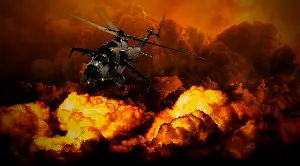Tactical environment software
Published:
 Tactical Environment software refers to computer programs or software systems that are specifically designed for military or tactical operations. This type of software provides real-time information and data to help military personnel make informed decisions and respond quickly to changing conditions on the ground. Tactical Environment software often includes features such as mapping, threat assessment, communication tools, and mission planning to enhance operational efficiency and situational awareness.
Tactical Environment software refers to computer programs or software systems that are specifically designed for military or tactical operations. This type of software provides real-time information and data to help military personnel make informed decisions and respond quickly to changing conditions on the ground. Tactical Environment software often includes features such as mapping, threat assessment, communication tools, and mission planning to enhance operational efficiency and situational awareness.
Tactical Environment software typically includes capabilities for geographic information systems (GIS), mapping and imagery, meteorology, air and ground surveillance, and communications. The software can be used in a variety of situations, including military training exercises, reconnaissance missions, and combat operations. It is designed to be highly scalable, configurable, and interoperable, allowing military personnel to use the software in a wide range of environments and situations.
The goal of Tactical Environment software is to provide military personnel with the information they need to operate effectively and make informed decisions, while reducing the risk of errors and increasing situational awareness. By providing real-time data and information, this software can help military personnel make more informed decisions, respond more quickly to changes in the tactical environment, and improve mission outcomes.
..
Tactical Environment software typically includes a variety of entities or components that work together to provide the desired functionality. Some common entities found in this type of software include:
Geographical Information System (GIS): A GIS is a database of maps and other geographic information that can be used to support military operations. This includes satellite imagery, topographical maps, and other types of data.
Mapping and Imagery: This entity provides maps, satellite images, and other types of imagery that are useful for military operations. It can also include tools for analyzing and manipulating this data to support decision making.
Meteorology: Tactical Environment software often includes meteorology tools that provide real-time information about weather conditions in the area of operations. This can include data on wind speed and direction, temperature, and other weather parameters.
Surveillance: This entity provides tools for monitoring and tracking the movement of people and vehicles on the ground, as well as aircraft in the air. This data can be used to support reconnaissance and surveillance missions.
Communications: Tactical Environment software may include tools for communicating and exchanging information between military personnel and other stakeholders, including other military units, command centers, and civilian agencies.
..
The level of “smartness” of a Tactical Environment software solution can vary depending on several factors, including its design, the quality of its underlying data, and the algorithms used to process and analyze the data. However, in general, Tactical Environment software is designed to be highly automated and to make use of advanced algorithms and artificial intelligence (AI) techniques to support military operations.
Some key features that can contribute to the “smartness” of a Tactical Environment software solution include:
Real-time data processing: The software is capable of processing large amounts of data in real-time and providing relevant information to military personnel in a timely manner.
Advanced algorithms: The software uses advanced algorithms, such as machine learning, to analyze data and make predictions based on that data. This can help military personnel make informed decisions in rapidly changing situations.
Decision support: The software can provide recommendations and decision-making support to military personnel based on the analysis of data and other information.
Predictive modeling: The software can use predictive modeling techniques to anticipate future events and conditions, allowing military personnel to plan and prepare accordingly.
..
Tactical Environment software typically supports a variety of standards to ensure compatibility and interoperability with other systems and technologies. Some common standards that this type of software may support include:
Geospatial Information and Services (OGC) standards: These standards define how geospatial data is stored, managed, and shared, and include standards for maps, imagery, and other geographic data.
Military Standards (MIL-STD): These standards are used by the military to ensure that equipment and systems are interoperable and meet certain performance requirements. They cover a wide range of areas, including communications, mapping, and navigation.
International Standards Organization (ISO) standards: These standards provide a framework for information technology and include standards for data exchange, data quality, and other areas.
Communication protocols: Tactical Environment software may support various communication protocols, such as TCP/IP, to facilitate communication between different systems and components.
Data exchange standards: The software may support data exchange standards, such as the Extensible Markup Language (XML), to allow for the exchange of information between different systems and technologies.